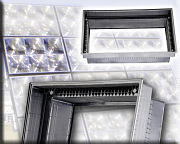Feb 27 2009
The housing for a new, innovatively designed photovoltaic module that concentrates the sun’s rays is made with DuPont™ Rynite® PET resin. The rugged, dimensionally stable molded housing helps focus concentrator optics and boost solar energy conversion.

Concentrated photovoltaic (or CPV) uses mirrors or lenses to ‘concentrate’ or focus light from a relatively broad collection area onto a small area (as little as 1 centimeter squared [cm²]) of active semiconductor photovoltaic material based on Group III and V elements in the periodic table. These systems show very high cell conversion efficiencies of over 36 percent. The concentrated photovoltaic modules, developed by the Spanish start-up company Concentración Solar La Mancha S.L., consist of six concentrator elements and automatically track the sun’s movement across the sky to within 0.2 degrees of accuracy. Such precision enables them to achieve efficiency levels of 20 to 24 percent in terms of electricity production, compared to 15 to 16 percent for modules with conventional silicon cells.
The lenses are housed and supported in a frame molded from a mica- and glass-reinforced grade of DuPont™ Rynite® PET resin, selected as an alternative to powder-coated aluminum. “We were clear from the outset that we wanted to replace metal with a high-performance polymer due to the benefits associated with the change, including corrosion resistance, design flexibility and lower processing and material costs. Through the integration of additional functions in the housing, we were able to reduce the number of manufacturing steps,” said Miguel Trinidad Aragon, CEO of Concentración Solar La Mancha.
Rynite® was selected for its exceptionally low warpage, high stiffness and excellent electrical insulating properties. Exposed to around-the-clock outdoor weather conditions, the material was required to provide excellent heat (temperatures of up to 85 degrees Celsius) and ultraviolet resistance, as well as the structural support required for the entire CPV module to withstand high winds.